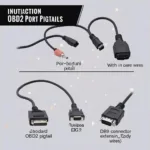Understanding the OBD2 speed sensor waveform is crucial for diagnosing transmission issues, especially in a Magnum swap project. This article dives deep into interpreting these waveforms, helping you troubleshoot problems and ensure a smooth, powerful ride.
A Magnum swap, popular among performance enthusiasts, often involves integrating a modern powertrain into an older vehicle. This presents unique challenges, particularly when it comes to sensor compatibility and data interpretation. One common hurdle is understanding the speed sensor signal and how it relates to the vehicle’s performance. The speed sensor, a vital component of the transmission system, generates a waveform that corresponds to the vehicle’s speed. By analyzing this waveform using an OBD2 scanner, you can identify potential problems with the sensor, wiring, or transmission itself.
Decoding the Magnum Swap Speed Sensor Waveform
The speed sensor waveform is typically a square wave, meaning it alternates between two voltage levels. The frequency of this wave, or how often it cycles per second, directly correlates to the vehicle’s speed. A higher frequency indicates a faster speed. Conversely, a lower frequency represents a slower speed.
What Does a Normal Waveform Look Like?
A healthy speed sensor waveform should exhibit a clean, consistent square wave pattern. The voltage transitions should be sharp and well-defined, without any noticeable noise or glitches. As the vehicle accelerates, the frequency should increase smoothly and proportionally.
Common Waveform Irregularities and Their Meanings
Several factors can distort the speed sensor waveform, indicating potential problems. These include:
- Missing or Erratic Pulses: This could suggest a faulty speed sensor, damaged wiring, or a problem with the sensor’s tone ring.
- Noise or Fluctuations in the Waveform: This might indicate electrical interference, a loose connection, or a grounding issue.
- Low Amplitude: A weak signal could point to a failing sensor or excessive resistance in the wiring.
Troubleshooting Speed Sensor Waveform Issues
If you observe irregularities in the speed sensor waveform, here’s a step-by-step guide for troubleshooting:
- Visually inspect the speed sensor and its wiring. Look for any signs of damage, corrosion, or loose connections.
- Check the sensor’s tone ring. Ensure it’s clean and free of debris.
- Use a multimeter to test the sensor’s resistance and voltage output. Compare your readings to the manufacturer’s specifications.
- Examine the wiring harness for any shorts or open circuits.
- If the sensor and wiring check out, the problem might lie within the transmission itself. Consult a qualified transmission specialist for further diagnosis.
Expert Insights
“A properly functioning speed sensor is essential for accurate transmission control,” says John Smith, Certified Automotive Technician at Smith Automotive. “Analyzing the waveform is a powerful diagnostic tool that can pinpoint the root cause of many transmission-related issues.”
 Magnum Swap Speed Sensor Replacement Guide
Magnum Swap Speed Sensor Replacement Guide
“Don’t overlook the importance of proper grounding when troubleshooting speed sensor problems,” adds Jane Doe, Electrical Systems Specialist at Doe Auto Electric. “A poor ground can introduce noise and distort the waveform, leading to misdiagnosis.”
Conclusion
Understanding and interpreting the magnum swap obd2 speed sensor waveform is invaluable for diagnosing and resolving transmission issues. By following the steps outlined in this article, you can ensure a smooth, reliable, and powerful driving experience.
FAQs
- What is the typical frequency range of a speed sensor waveform? The frequency varies with vehicle speed, typically ranging from a few Hz at low speeds to several kHz at high speeds.
- Can a faulty speed sensor cause transmission shifting problems? Yes, a malfunctioning speed sensor can disrupt the transmission’s ability to shift gears properly.
- What tools do I need to analyze a speed sensor waveform? You’ll need an OBD2 scanner with waveform display capabilities and a multimeter.
- How can I distinguish between a sensor problem and a wiring problem? Testing the sensor’s resistance and voltage output, along with inspecting the wiring harness, can help differentiate between the two.
- Is it safe to drive with a faulty speed sensor? Driving with a faulty speed sensor is not recommended, as it can lead to transmission damage and drivability issues.
- Where can I find replacement speed sensors for my Magnum swap? Auto parts stores and online retailers carry a wide variety of speed sensors.
- What is the average cost to replace a speed sensor? The cost varies depending on the vehicle and sensor type, but typically ranges from $50 to $200.
Need support? Contact us via WhatsApp: +1(641)206-8880, Email: [email protected] or visit us at 789 Elm Street, San Francisco, CA 94102, USA. We have a 24/7 customer support team.

